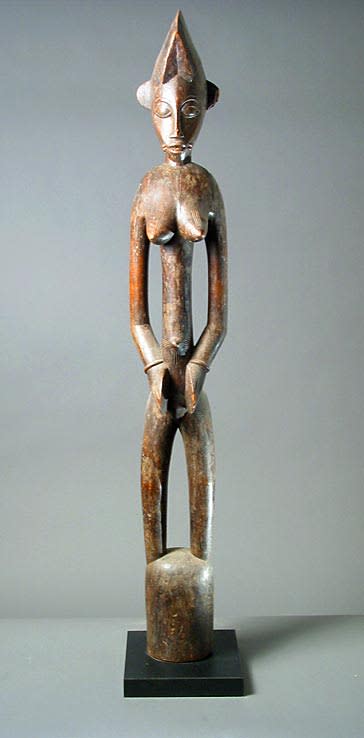Female Senufo Wooden Pombilele Rhythm Pounder, 20th Century CE
Wood
7 x 46.75
PF.5741 (LSO)
Further images
This sensitively-rendered piece is an exceptional pombilele “rhythm pounder” made by the Senufo of the Ivory Coast and Mali. It is traditional in many requests, but is unusual in the...
This sensitively-rendered piece is an exceptional pombilele “rhythm pounder” made by the Senufo of the Ivory Coast and Mali. It is traditional in many requests, but is unusual in the delicately naturalistic manner in which the face and upper thorax, in particular, have been rendered. It stands on an integrated, domed columnar base with footless legs. The legs are sinuous, straight and short, with a long torso, a solid thorax with integration of shoulders, breasts and chest, and long arms resting on the pelvis. The head is long, with a crested coiffure, a wide brow and pointed chin. The face is very delicately rendered, with rounded eyes, a straight nose and sensitively poised mouth. It is also rendered in fairly low relief, which gives it more expressivity. As is normal for single pombilele, it is female. Detail is limited save for scars at the sides of the mouth, nipples, umbilicus and wrist bracelets.
The Senufo group, based in the Ivory Coast and Mali area, has a long history of using highly decorated objects in many aspects of everyday life. However, their extremely high level of skill in woodcarving is nowhere better seen than in the realm of their magical-religious art. At the heart of Senufo society is a patriarchal groups of elders known as the Poro society, which is responsible for many religious and more urbane functions to do with the running of the tribal group. Their ceremonial events are often associated with dancing, music and the use of Pombilele sculptures.
“Pombilele” literally translates as “those who give birth”, and traditionally constitute a pair of figures (one male, one female) who represent primordial humanity and the ancestry of all humankind. Most examples, however, are of single, female figures. The appearance of these figures is relatively homogenous, being tall, slim and somewhat angular. However, the personal characteristics of each sculpture were often based upon a dream or vision by a Poro elder. There is also some social and geographic variability. The figures were used as pounding devices (holding each arm) to keep the rhythm for dancing, or were stood for purposes of contemplation in the middle of the Poro society’s sacred enclosures. They are also used for the interment of prominent Poro members; they are carried to the graveside with the dead body, then used to tamp down the earth on top of the grave, to ensure that the spirit of the dead is directed to the afterlife rather than returning to haunt the living.
This is a striking and attractive piece of African art.
The Senufo group, based in the Ivory Coast and Mali area, has a long history of using highly decorated objects in many aspects of everyday life. However, their extremely high level of skill in woodcarving is nowhere better seen than in the realm of their magical-religious art. At the heart of Senufo society is a patriarchal groups of elders known as the Poro society, which is responsible for many religious and more urbane functions to do with the running of the tribal group. Their ceremonial events are often associated with dancing, music and the use of Pombilele sculptures.
“Pombilele” literally translates as “those who give birth”, and traditionally constitute a pair of figures (one male, one female) who represent primordial humanity and the ancestry of all humankind. Most examples, however, are of single, female figures. The appearance of these figures is relatively homogenous, being tall, slim and somewhat angular. However, the personal characteristics of each sculpture were often based upon a dream or vision by a Poro elder. There is also some social and geographic variability. The figures were used as pounding devices (holding each arm) to keep the rhythm for dancing, or were stood for purposes of contemplation in the middle of the Poro society’s sacred enclosures. They are also used for the interment of prominent Poro members; they are carried to the graveside with the dead body, then used to tamp down the earth on top of the grave, to ensure that the spirit of the dead is directed to the afterlife rather than returning to haunt the living.
This is a striking and attractive piece of African art.





